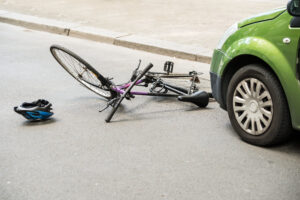When drivers and other individuals behave negligently, bicycle accidents that lead to debilitating injuries can occur. The total value of a bicycle accident claim or lawsuit depends on the circumstances surrounding the accident, the extent of the victim’s injuries, and other factors.
One of the best ways to maximize the overall settlement or litigation value of your bicycle accident case is to retain an experienced bicycle accident lawyer to represent you.
Your Phoenix bicycle accident attorney can handle all settlement negotiations with insurance companies, estimate the likely settlement value of your case, and, if necessary, pursue litigation in the court system for you.
How Do Bike Accidents Frequently Occur?
Bicycle accidents often occur when others fail to prioritize safety, leading to unfortunate consequences for cyclists. One common scenario involves motorists who neglect to check their blind spots before making turns, putting cyclists in a vulnerable position.
These lapses in attention can result in collisions between bicycles and cars, often causing injuries to the bicycle rider.

Moreover, drivers opening car doors without checking for approaching cyclists pose a significant threat. This oversight, known as dooring, can cause severe injuries if a cyclist collides with the suddenly opened door. It emphasizes the need for motorists to watch for cyclists when exiting their vehicles – especially near bicycle lanes and in parking lots and parking garages.
Additionally, poorly maintained roads and infrastructure contribute to bicycle accidents. Potholes, uneven surfaces, and lack of proper signage can make cycling hazardous.
Local authorities often play a crucial role in ensuring that road conditions are safe for cyclists, and neglect in this regard can lead to serious accidents and debilitating injuries.
Furthermore, the absence of designated bike lanes or inadequate cycling infrastructure is a recurring issue. When cyclists are forced to share the road with heavy traffic due to a lack of dedicated lanes, the risk of accidents rises.
Motorists may not be accustomed to sharing space with cyclists, increasing the likelihood of collisions.
In general, bike accidents resulting from others’ negligence often stem from a range of scenarios, including motorists' failure to check blind spots, dooring incidents, poorly maintained roads, and inadequate cycling infrastructure.
Motorists must pay attention to their surroundings and consider the safety of cyclists at all times to prevent serious accidents from occurring. When they do not, bicycle accident lawyers can hold them accountable for their negligence.
Frequent Injuries in Bicycle Accidents
When others act negligently, it can lead to injuries for cyclists. One common consequence of this negligence is the occurrence of collisions between bicycles and motor vehicles. These collisions often result in serious injuries, such as broken bones, head trauma, and internal injuries, as the impact between the cyclist and the larger, more protected vehicle can be forceful.
Another common injury stemming from negligence is road rash, which happens when a collision or sudden stop throws a cyclist off their bicycle. The friction between the cyclist's body and the road surface can cause painful abrasions and skin injuries. Road rash requires medical attention (such as stitches or medical procedures) to ensure proper healing and prevent infections.

Additionally, dooring incidents, where a motorist opens their car door without checking for oncoming cyclists, can lead to significant injuries. Cyclists may collide with the door, resulting in injuries such as broken limbs, facial injuries, or even more severe harm. The sudden nature of dooring incidents makes it challenging for cyclists to avoid the collision, heightening the risk of injury.
Poorly maintained roads and infrastructure further increase the risks of injuries resulting from others’ negligence. Potholes, uneven surfaces, and lack of proper signage can make cycling hazardous.
Cyclists navigating these conditions may experience accidents resulting in injuries ranging from minor bruises to more severe bone fractures.
Injuries resulting from bicycle accidents due to others’ negligence encompass a range of consequences, including broken bones, head trauma, internal injuries, road rash, fractures, and more.
If you suffered any of these injuries in a recent bicycle crash, your bicycle accident lawyer can handle the legal steps of your case while you attend ongoing medical appointments and focus your full attention on getting better.
Factors that May Affect the Value of a Bicycle Accident Claim or Lawsuit
Several factors determine the value of a bicycle accident claim or lawsuit. The extent of injuries that the cyclist suffers is a primary factor influencing the total compensation award in the case. Severe injuries, such as broken bones, head trauma, or long-term disabilities, often lead to higher settlement amounts due to the significant effect on the victim's life, including medical expenses and potential loss of earning capacity.
Medical expenses – another crucial element – contribute significantly to the overall value of a bicycle accident case. Costs associated with hospitalization, surgeries, medications, rehabilitation, and ongoing medical care are carefully assessed. The more extensive and long-term the medical treatment required, the higher the potential compensation to cover these substantial expenses.

Lost income is also a factor in the value of a bike accident claim. If the cyclist is unable to work due to their accident-related injuries, this item of compensation seeks to address the financial hardships resulting from the temporary or permanent loss of income.
This includes considerations for missed workdays, diminished work capacity, and potential career changes resulting from the injuries.
Property damage, referring to the damage inflicted on the bicycle and any accompanying gear, further contributes to the overall valuation of the claim. Repair or replacement costs are factored in, recognizing the financial burden placed on the cyclist to restore their means of transportation and essential equipment.
Pain and suffering, while challenging to quantify, are also important components of the compensation calculation. The physical and emotional distress that the injured cyclist experienced due to the accident and subsequent injuries are important considerations. This includes pain, emotional anguish, and any long-term psychological effects resulting from the traumatic experience.
Moreover, liability plays a key role in determining compensation amounts. Establishing who is at fault for the bike accident is crucial in assessing the strength of the case. If the negligence of another party is evident, it strengthens the likelihood of a higher settlement offer or litigation result.
Insurance coverage limits also affect the overall value of a bicycle accident claim or lawsuit. The available coverage from the at-fault party’s insurance provider may cap the potential compensation. Understanding these limits is important in managing expectations regarding the financial recovery achievable through a claim or lawsuit.
The final value of a bicycle accident claim or lawsuit hinges on various factors, including the severity of injuries, medical expenses, lost income, property damage, pain and suffering, liability, and insurance coverage limits.
Thorough consideration of these elements is essential in pursuing fair compensation for the physical, emotional, and financial effects of the bicycle collision.
Proving a Bicycle Accident Case
Proving the legal elements of a bicycle accident claim or lawsuit requires a careful examination of key factors to establish a compelling case. Central to this process is demonstrating negligence – a crucial legal element in personal injury cases.
To do this, the injured cyclist must demonstrate that the at-fault party had a duty of care – and breached that duty through their actions or inactions. The cyclist must also show that this breach directly resulted in the cyclist’s injuries and damages.
A critical aspect of establishing negligence is providing evidence of the legal duty of care that the at-fault party owed. In the context of a bicycle accident, this often involves demonstrating that motorists or other involved parties needed to adhere to traffic rules and exercise caution. Photographic evidence, eyewitness accounts, and expert testimony may all contribute to supporting this aspect of the case.

Moreover, the injured cyclist must establish that the other party breached their duty of care in some way. This involves showcasing how the at-fault party failed to uphold their duty of care, leading to the bicycle accident. This may involve actions like reckless driving, failure to yield, or disregarding traffic signals.
Traffic camera footage, police reports, and witness statements can illustrate this breach of duty.
Establishing causation is equally important in proving a bicycle accident claim or lawsuit. The injured cyclist must demonstrate that the breach of duty directly caused the injuries which the cyclist suffered.
Medical records, expert medical testimony, and accident reconstruction reports may all play a role in establishing a clear link between the at-fault party’s actions and the resulting harm to the cyclist.
Furthermore, quantifying damages is essential to determine the compensation sought in the claim or lawsuit. This involves presenting evidence of the economic and non-economic losses incurred due to the accident, such as medical bills, lost income, property damage, and pain and suffering. Thorough documentation and supporting evidence can help to build a persuasive case for fair compensation.
Proving the legal elements of a bicycle accident claim or lawsuit involves establishing negligence, demonstrating the breach of duty, establishing causation, and quantifying damages.
Robust evidence, including photographs, eyewitness accounts, expert testimony, medical records, and accident reconstruction reports, can build a compelling case that demonstrates the at-fault party’s responsibility for the cyclist’s injuries and justifies a favorable compensation award.
When to Pursue Litigation in a Bicycle Accident Case
Deciding when to pursue litigation in a bicycle accident case requires careful consideration of various factors. If attempts to resolve the matter through negotiation or settlement prove unsuccessful, you may need to turn to litigation.
An important aspect in making this decision is the extent of the injuries and damages which the cyclist suffered. Severe injuries that result in significant medical expenses, lost income, and substantial pain and suffering may warrant pursuing legal action.

Likewise, the liability of the at-fault party and the strength of the evidence supporting the cyclist’s claims are important considerations. If there is clear evidence demonstrating the other party’s negligence and a strong case can be built, litigation may be a strategic step toward securing fair compensation.
On the other hand, if liability is unclear or the evidence is weak, alternative dispute resolution (ADR) methods, such as mediation or arbitration, may be necessary to avoid the uncertainties of a trial.
Understanding the potential outcomes of litigation is also crucial. Trials involve presenting the case before a judge or jury, allowing them to determine liability and award damages. While trials provide a formal legal process, they can be time-consuming and costly.
On the contrary, ADR methods offer a more collaborative approach, where parties work with a neutral third party to reach a mutually agreeable resolution. ADR can often be a faster and less expensive option compared to a trial.
Parties involved in a bicycle accident case must also be aware of the potential emotional toll of litigation. Trials can be stressful, and the process may prolong the case resolution. On the other hand, ADR methods provide a more flexible and collaborative environment, potentially reducing the emotional strain on the parties involved.
The decision to pursue litigation in a bicycle accident case hinges on the severity of injuries, the strength of evidence, and the potential outcomes of legal action.
If negotiations fail and the situation warrants legal intervention, a bike accident lawyer can explain your options, whether a trial or ADR. An experienced bicycle accident attorney can estimate the likely settlement or verdict value of your case and help you decide between settlement and litigation.
Contact a Knowledgeable Bicycle Accident Lawyer Today

If you recently sustained injuries in a bicycle crash resulting from someone else’s negligence, an experienced bicycle accident attorney in your area will do everything possible to maximize the final settlement or verdict value of your case.
During settlement negotiations, your lawyer can highlight the strengths of your case by pointing to favorable medical records, police reports, and other documentation.
If the insurance company does not compensate you fairly for your losses, your attorney can aggressively represent you during all litigation proceedings in court and introduce favorable evidence for you.